Gaels
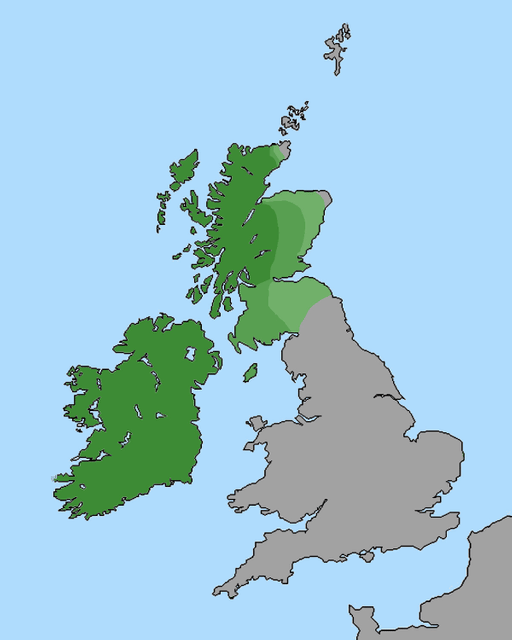
Gaels

| Total population | |
|---|---|
| 1.9 million(linguistic)* | |
| Regions with significant populations | |
| Ireland | 1,770,000 (linguistic)[4] |
| United Kingdom | 122,518 (linguistic)[5] |
| United States | 27,475 (linguistic)[6] |
| Canada | 9,000 (linguistic)[7] |
| Australia | 2,717 (linguistic)[8] |
| New Zealand | 670 (linguistic) |
| Languages | |
| Gaelic languages(Irish]·Scottish Gaelic·Manx) also non-GaelicEnglishandScots | |
| Religion | |
| Christianity·(historic:Paganism) | |
| Related ethnic groups | |
| Norse-Gaels·Gaelicised Normans | |
The Gaels (/ɡeɪlz/; Irish: Na Gaeil [ɡeːl]; Scottish Gaelic: Na Gàidheil [ˈkɛː.el]; Manx: Ny Gaeil [ge:l]) are an ethnolinguistic group native to northwestern Europe.[1] They are associated with the Gaelic languages: a branch of the Celtic languages comprising Irish, Manx and Scottish Gaelic. Historically, the ethnonyms Irish and Scots referred to the Gaels in general, but the scope of those ethnicities and nationalities is today more complex.
Gaelic language and culture originated in Ireland, extending to Dál Riata in western Scotland. In antiquity the Gaels traded with the Roman Empire and also raided Roman Britain. In the Middle Ages, Gaelic culture became dominant throughout the rest of Scotland and the Isle of Man. There was also some Gaelic settlement in Wales and Cornwall. In the Viking Age, small numbers of Vikings raided and settled in Gaelic lands, becoming the Norse-Gaels. In the 9th century, Dál Riata and Pictland merged to form the Gaelic Kingdom of Alba. Meanwhile, Gaelic Ireland was made up of several kingdoms, with a High King often claiming lordship over them.
In the 12th century, Normans conquered parts of Ireland (leading to centuries of conflict), while parts of Scotland became Normanized. However, Gaelic culture remained strong throughout Ireland, the Scottish Highlands and Galloway. In the early 17th century, the last Gaelic kingdoms in Ireland fell under English control. James I sought to subdue the Gaels and wipe out their culture; in Ireland by colonizing Gaelic land with English-speaking British settlers, and in the Scottish Highlands via repressive laws such as the Statutes of Iona. In the following centuries the Gaelic language was suppressed and mostly supplanted by English. However, it continues to be the main language in Ireland's Gaeltacht and Scotland's Outer Hebrides. The modern descendants of the Gaels have spread throughout Britain, the Americas and Australasia.
Traditional Gaelic society is organised into clans, each with its own territory and king (or chief), elected through tanistry. The Irish were previously pagans who worshipped the Tuatha Dé Danann, venerated the ancestors and believed in an Otherworld. Their four yearly festivals – Samhain, Imbolc, Beltane and Lughnasa – continued to be celebrated into modern times. The Gaels have a strong oral tradition, traditionally maintained by shanachies. Inscription in the ogham alphabet began in the 4th century. Their conversion to Christianity accompanied the introduction of writing in the Roman alphabet, and Irish Gaelic has the oldest vernacular literature in western Europe. Irish mythology and Brehon law were preserved, albeit Christianised. Gaelic monasteries were renowned centres of learning and played a key role in developing Insular art, while Gaelic missionaries and scholars were highly influential in western Europe. In the Middle Ages, most Gaels lived in roundhouses and ringforts. The Gaels had their own style of dress, which (in Scotland) became the belted plaid and kilt. They also have distinctive music, dance, and sports. Gaelic culture continues to be a major component of Irish, Scottish and Manx culture.
| Total population | |
|---|---|
| 1.9 million(linguistic)* | |
| Regions with significant populations | |
| Ireland | 1,770,000 (linguistic)[4] |
| United Kingdom | 122,518 (linguistic)[5] |
| United States | 27,475 (linguistic)[6] |
| Canada | 9,000 (linguistic)[7] |
| Australia | 2,717 (linguistic)[8] |
| New Zealand | 670 (linguistic) |
| Languages | |
| Gaelic languages(Irish]·Scottish Gaelic·Manx) also non-GaelicEnglishandScots | |
| Religion | |
| Christianity·(historic:Paganism) | |
| Related ethnic groups | |
| Norse-Gaels·Gaelicised Normans | |
Ethnonyms
Throughout the centuries, Gaels and Gaelic-speakers have been known by a number of names.
The most consistent of these have been Gael, Irish and Scots. The latter two have developed more ambiguous meanings, due to the early modern concept of the nation state, which encompasses non-Gaels. Other terms, such as Milesian, are not as often used.[12] An Old Norse name for the Gaels was Vestmenn ('Westmen').[13]*From%20Pictland%20to%20Alba%2C%20789%E2%80%9310]]nformally, archetypal forenames such as Tadhg [14]
History of the term
The word Gaelic is first recorded in print in the English language in the 1770s,[15] replacing the earlier word Gathelik which is attested as far back as 1596.[15] Gael, defined as a "member of the Gaelic race", is first attested in print in 1810.[16] The name ultimately derives from the Old Irish word Goídel/Gaídel, commonly spelled Gaoidheal in pre-spelling reform Modern Irish, but today officially spelled Gaeil (plural) or Gael (singular; the word is spelled Gael in Manx and Gàidheal (singular) and Gàidheil (plural) in Scottish Gaelic). In early modern Irish, the words Gaelic and Gael were spelled respectively Gaoidhealg (Goídelc in Old Irish) and Gaoidheal (singular), Gaoidheil/Gaoidhil (plural).[17] The more antiquarian term Goidels came to be used by some due to Edward Lhuyd's work on the relationship between Celtic languages. This term was further popularised in academia by John Rhys; the first Professor of Celtic at Oxford University; due to his work Celtic Britain (1882).[18]
According to the scholar John T. Koch, the Old Irish form of the name, Goídel (also spelled Gaídel), was borrowed from a Primitive Welsh form Guoidel roughly meaning 'forest people', 'wild men' or, later, 'warriors'.[17] Old Welsh Guoidel is recorded as a personal name in the Book of Llandaff. The root of the name is cognate at the Proto-Celtic level Old Irish fíad 'wild', and Féni, derived ultimately from the Proto-Indo-European **weidh-n-jo-*.[17][19] This latter word is the origin of Fianna and Fenian.
Irish
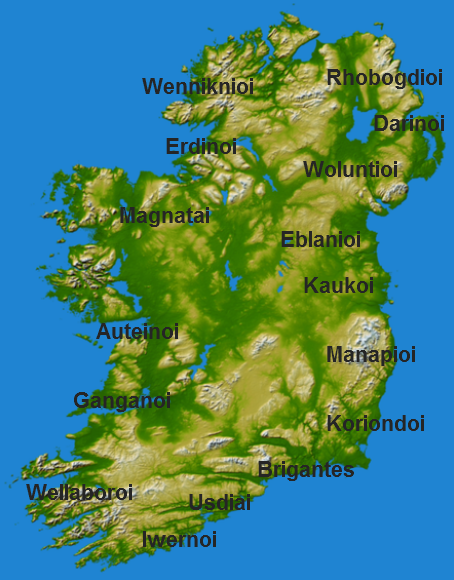
The Iverni are one of the population groups mentioned in Ptolemy's Geographia
A common name, passed down to the modern day, is Irish; this existed in the English language during the 11th century in the form of Irisce, which derived from the stem of Old English Iras "inhabitant of Ireland", from Old Norse irar.[20] The ultimate origin of this word is thought to be from the Old Irish Ériu, which is from Old Celtic Iveriu, likely associated with the Proto-Indo-European term pi-wer- meaning "fertile".[20] Ériu is mentioned as a goddess in the Lebor Gabála Érenn as a daughter of Ernmas of the Tuatha Dé Danann. Along with her sisters Banba and Fódla, she is said to have made a deal with the Milesians to name the island after her.
The ancient Greeks; in particular Ptolemy in his 2nd century Geographia, possibly based on earlier sources; located a group known as the Iverni (Greek: Ιουερνοι) in the south-west of Ireland.[21] This group has been associated with the Érainn of Irish tradition by T. F. O'Rahilly and others.[21] The Érainn; claiming descent from a Milesian eponymous ancestor named Ailill Érann; were the hegemonic power in Ireland prior to the rise of the descendants of Conn of the Hundred Battles and Mug Nuadat. The Érainn included peoples such as the Corcu Loígde and Dál Riata. Ancient Roman writers, such as Caesar, Pliny and Tacitus, derived from "Ivernia" the name Hibernia.[21] Thus the name Hibernian also comes from this root (although the Romans tended to call the isle Scotia, and the Gaels "Scoti").[22]
Scots
From the 5th to 10th centuries, early Scotland was home to the following people and cultures: the Picts, Dál Riata also known as Gaels, the Britons, Angles and lastly the Vikings.[23]*Picts%2C%20Gaels%20and%20Scots%3A%20Early%20Histo]]he Romans began to use the term Scoti Latin ard.[24][25] In the context of the times, the Gaels were raiding the west coast of Britain for hostages, and they took part in the Great Conspiracy; it is thus conjectured that the term means "raider, pirate". Although the Dál Riata settled in Argyll in the 6th century, the term "Scots" did not just apply to them, but to Gaels in general. Examples can be taken from Johannes Scotus Eriugena and other figures from Hiberno-Latin culture and the Schottenkloster founded by Irish Gaels in Germanic lands. It is also worth noting that eponymous characters were created in medieval Irish pseudo-histories: Scota, described as an Egyptian princess, and her husband Goídel Glas.
The Gaels of northern Britain referred to themselves as Albannaich in their own tongue and their realm as the Kingdom of Alba (founded as a successor state to Pictland and Dál Riata). Germanic groups tended to refer to the Gael as "Scottas"[25] and so when Anglo-Saxon influence grew at court with Duncan II, the Latin Rex Scottorum began to be used and the realm was known as Scotland; this process and cultural shift was put into full effect under David I, who let the Normans come to power and furthered the Lowland-Highland divide. Lowland Germanics in Scotland spoke a language called Inglis, which they started to call Scottis (Scots) in the 16th century, while they in turn began to refer to Scottish Gaelic as Erse (from 'Irish').[26]
Population
Kinship groups
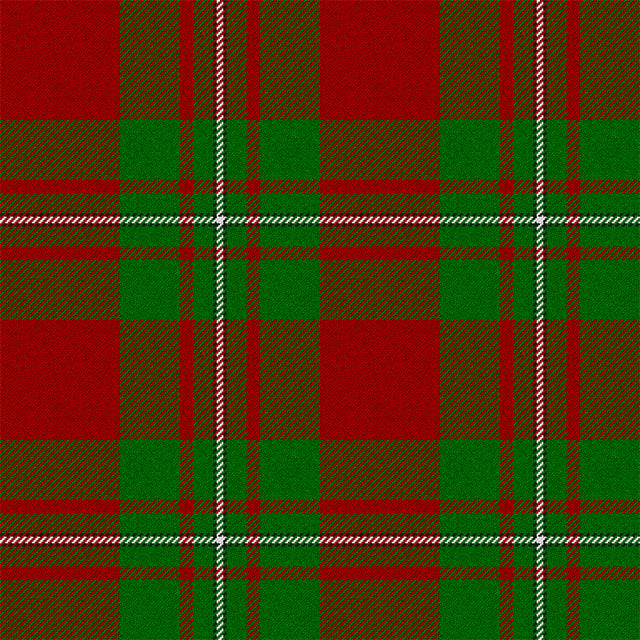
Clan tartan of the MacGregors. Distinctive patterns were adopted during the Victorian era.
In traditional Gaelic society, a patrilineal kinship group is referred to as a clann[27] or, in Ireland, a fine;[28][29] both in technical use signifying a dynastic grouping descended from a common ancestor, much larger than a personal family, which may also consist of various kindreds and septs (fine is not to be confused with the term fian 'a band of roving men whose principal occupations were hunting and war, also a troop of professional fighting-men under a leader; in wider sense a company, number of persons; a warrior (late and rare);[30]).
Using the Munster-based Eóganachta as an example, members of this clann claim patrilineal descent from Éogan Mór. It is further divided into major kindreds, such as the Eóganacht Chaisil, Glendamnach, Áine, Locha Léin and Raithlind.[31][32] These kindreds themselves contain septs that have passed down as Irish Gaelic surnames, for example the Eóganacht Chaisil includes O'Callaghan, MacCarthy, O'Sullivan and others.[33][34]
The Irish Gaels can be grouped into the following major historical groups; Connachta (including Uí Néill, Clan Colla, Uí Maine, etc.), Dál gCais, Eóganachta, Érainn (including Dál Riata, Dál Fiatach, etc.), Laigin and Ulaid (including Dál nAraidi). In the Highlands, the various Gaelic-originated clans tended to claim descent from one of the Irish groups, particularly those from Ulster. The Dál Riata (i.e. – MacGregor, MacDuff, MacLaren, etc.) claimed descent from Síl Conairi, for instance.[35] Some arrivals in the High Middle Ages (i.e. – MacNeill, Buchanan, Munro, etc.) claimed to be of the Uí Néill. As part of their self-justification; taking over power from the Norse-Gael MacLeod in the Hebrides; the MacDonalds claimed to be from Clan Colla.[36][37]
For the Irish Gaels, their culture did not survive the conquests and colonisations by the English between 1534 and 1692 (see History of Ireland (1536–1691), Tudor conquest of Ireland, Plantations of Ireland, Cromwellian conquest of Ireland, Williamite War in Ireland. As a result of the Gaelic revival, there has been renewed interest in Irish genealogy; the Irish Government recognised Gaelic Chiefs of the Name since the 1940s.[38] The Finte na hÉireann (Clans of Ireland) was founded in 1989 to gather together clan associations;[39] individual clan associations operate throughout the world and produce journals for their septs.[40] The Highland clans held out until the 18th century Jacobite risings. During the Victorian-era, symbolic tartans, crests and badges were retroactively applied to clans. Clan associations built up over time and Na Fineachan Gàidhealach (The Highland Clans) was founded in 2013.[41]
Human genetics
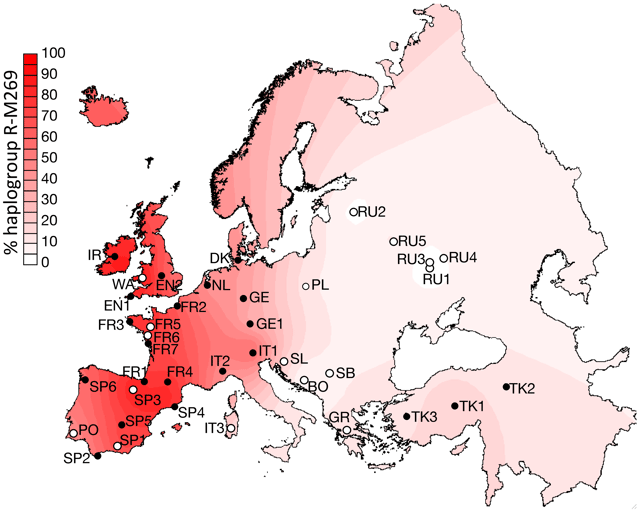
Distribution of Y-chromosomal Haplogroup R-M269 in Europe
At the turn of the 21st century, the principles of human genetics and genetic genealogy were applied to the study of populations of Irish origin.[42][43] It was found that the overwhelming majority belonged to haplogroup R1b in their Y-chromosome DNA (as with much of Western Europe).[44] The two other peoples who recorded higher than 85% for R1b in a 2009 study published in the scientific journal, PLOS Biology, were the Welsh and the Basques.[45]
The development of in-depth studies of DNA sequences known as STRs and SNPs have allowed geneticists to associate subclades with specific Gaelic kindred groupings (and their surnames), vindicating significant elements of Gaelic genealogy, as found in works such as the Leabhar na nGenealach. Examples can be taken from the Uí Néill (i.e. – O'Neill, O'Donnell, Gallagher, etc.), who are associated with R-M222[46] and the Dál gCais (i.e. – O'Brien, McMahon, Kennedy, etc.) who are associated with R-L226.[47] With regard to Gaelic genetic genealogy studies, these developments in subclades have aided people in finding their original clan group in the case of a non-paternity event, with Family Tree DNA having the largest such database at present.[48]
Demographics
In countries where Gaels live, census records documenting population statistics have exist.
The following chart shows the number of speakers of a Gaelic language (either "Gaeilge," also known as Irish, "Gàidhlig," known as Scottish Gaelic, or "Gaelg," known as Manx). The question of ethnic identity is slightly more complex, but included below are those who identify as ethnic Irish or Scottish. It should be taken into account that not all are of Gaelic descent, especially in the case of Scotland, due to the nature of the Lowlands. It also depends on the self-reported response of the individual and so is a rough guide rather than an exact science.
The two comparatively "major" Gaelic nations in the modern era are Ireland (which in the 2002 census had 185,838 people who spoke Irish "daily" and 1,570,894 who were "able" to speak it)[49] and Scotland (58,552 fluent "Gaelic speakers" and 92,400 with "some Gaelic language ability" in the 2001 census[50]). Communities where the languages still are spoken natively are restricted largely to the west coast of each country and especially the Hebrides islands in Scotland. However, a large proportion of the Gaelic-speaking population now lives in the cities of Glasgow and Edinburgh in Scotland, and Donegal, Galway, Cork and Dublin in Ireland. There are about 2,000 Scottish Gaelic speakers in Canada (Canadian Gaelic dialect), although many are elderly and concentrated in Nova Scotia and more specifically Cape Breton Island.[51] According to the U.S. Census in 2000,[6] there are more than 25,000 Irish-speakers in the United States, with the majority found in urban areas with large Irish-American communities such as Boston, New York City and Chicago.
| State | Gaeilge | Ethnic Irish | Gàidhlig | Ethnic Scots | Gaelg | Ethnic Manx |
|---|---|---|---|---|---|---|
| Ireland | 1,770,000 (2011)[4] | 3,969,319 (2011) | not recorded | not recorded | not recorded | not recorded |
| United Kingdom anddependencies[2] | 64,916 (2011)[5] | 1,101,994 (2011)[5][52] | 57,602 (2011) | 4,446,000 (2011) | 1,689 (2000)[53] | 38,108 (2011) |
| United States | 25,870 (2000)[6] | 33,348,049(2013)[54] | 1,605 (2000)[6] | 5,310,285(2013)[54] | not recorded | 6,955 |
| Canada | 7,500 (2011)[7] | 4,354,155(2006)[55] | 1,500 (2011)[7] | 4,719,850(2006)[55] | not recorded | 4,725 |
| Australia | 1,895 (2011)[8] | 2,087,800(2011)[56] | 822 (2001) | 1,876,560(2011) | not recorded | 46,000 |
| New Zealand | not recorded | 14,000 (2013)[57] | 670 (2006) | 12,792(2006) | not recorded | not recorded |
| Total | 1,870,181 | 44,875,317 | 62,199 | 16,318,487 | 1,689 | 95,788 |
Diaspora
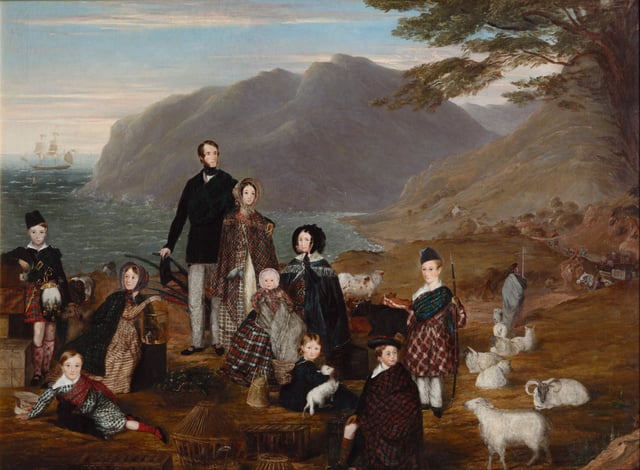
The Emigrants, painting from 1844. This depicts a Highland Scots family in Gaelic dress migrating to New Zealand.
As the Western Roman Empire began to collapse, the Irish (along with the Anglo-Saxons) were one of the peoples able to take advantage in Great Britain from the 4th century onwards. The proto-Eóganachta Uí Liatháin and the Déisi Muman of Dyfed both established colonies in today's Wales. Further to the north, the Érainn's Dál Riata colonised Argyll (eventually founding Alba) and there was a significant Gaelic influence in Northumbria[58] and the MacAngus clan arose to the Pictish kingship by the 8th century. Gaelic Christian missionaries were also active across the Frankish Empire. With the coming of the Viking Age and their slave markets, Irish were also dispersed in this way across the realms under Viking control; as a legacy, in genetic studies, Icelanders exhibit high levels of Gaelic-derived mDNA.[59]
Since the fall of Gaelic polities, the Gaels have made their way across parts of the world, successively under the auspices of the Spanish Empire, French Empire, and the British Empire. Core destinations for were Iberia, France, the West Indies, North America (what is today the United States and Canada) and Oceania (Australia and New Zealand). There has also been a mass "internal migration" within Ireland and Britain from the 19th century, with Irish and Scots migrating to the English-speaking industrial cities of London, Dublin, Glasgow, Liverpool, Manchester, Birmingham, Cardiff, Leeds, Edinburgh and others. Many underwent a linguistic "Anglicisation" and eventually merged with Anglo populations.
History
Origins
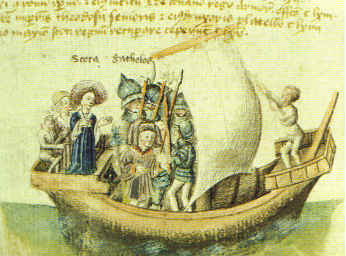
Scota and Goídel Glas voyaging from Egypt. From the 15th century chronicle the Scotichronicon
In their own national epic contained within medieval works such as the Lebor Gabála Érenn, the Gaels trace the origin of their people to an eponymous ancestor named Goídel Glas. He is described as a Scythian prince (the grandson of Fénius Farsaid), who is credited with creating the Gaelic languages. Goídel's mother is called Scota, described as an Egyptian princess (some modern writers associate her with Meritaten). The Gaels are depicted as wandering from place to place for hundreds of years; they spend time in Egypt, Crete, Scythia, the Caspian Sea and Getulia, before arriving in Iberia, where their king, Breogán, is said to have founded Galicia.[12]
The Gaels are then said to have sailed to Ireland via Galicia in the form of the Milesians, sons of Míl Espáine.[12] The Gaels fight a battle of sorcery with the Tuatha Dé Danann, the gods, who inhabited Ireland at the time. Ériu, a goddess of the land, promises the Gaels that Ireland shall be theirs so long as they pay tribute to her. They agree, and their bard Amergin recites an incantation known as the Song of Amergin. The two groups agree to divide Ireland between them: the Gaels take the world above, while the Tuath Dé take the world below (i.e. the Otherworld).
Advances in DNA studies have revealed some clues about the origin of the Gaels (who are associated with paternal R-L21).[44] Haplogroup R originated 26,800 years ago in Central Asia during the Last Ice Age. The R1b branch had broken off by the Paleolithic and its derivative R-M269 was found at the Pontic-Caspian steppe by the Chalcolithic (the Kurgan hypothesis makes these speakers of Proto-Indo-European).[44] First entering Europe proper 7,000 years ago, the Indo-Europeans developed bronze weapons and domesticated the horse, giving them the upper hand in their conquest of the Old Europe and the proliferation of their lineages.[44] After the R-L51 subclade founded the Unetice culture, a derivative R-L21 moved West, arriving in Britain c. 2100 BCE and Ireland c. 2000 BCE, becoming the Gaelic people.[44]
Ancient
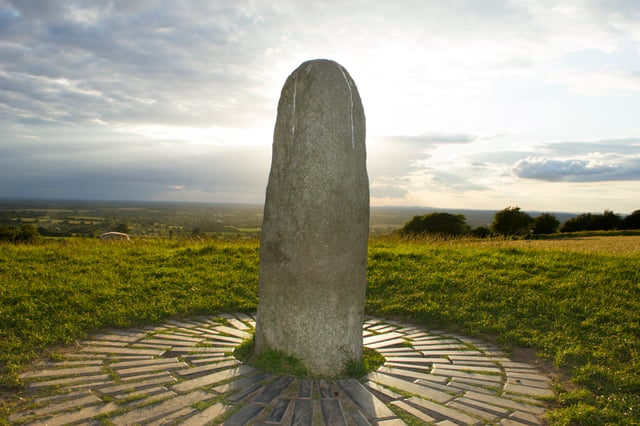
The Lia Fáil

The Isles in the 5th century. Mainly Goidelic areas. Mainly Pictish areas. Mainly Brythonic areas.
According to the Annals of the Four Masters, the early branches of the Milesian Gaels were the Heremonians, the Heberians and the Irians, descended from the three brothers Érimón, Éber Finn and Ír respectively. Another group were the Ithians, descended from Íth (an uncle of Milesius) who were located in South Leinster (associated with the Brigantes) but they later became extinct. The Four Masters date the start of Milesian rule from 1700 BCE. Initially, the Heremonians dominated the High Kingship of Ireland from their stronghold of Mide, the Heberians were given Munster and the Irians were given Ulster. At this early point of the Milesian-era, the non-Gaelic Fir Domnann held Leinster and the Fir Ol nEchmacht held what was later known as Connacht (possibly remnants of the Fir Bolg).
During the Iron Age there was heightened activity at a number of important royal ceremonial sites, including Tara, Dún Ailinne, Rathcroghan and Emain Macha.[60] Each was associated with a Gaelic tribe. The most important was Tara, where the High King (also known as the King of Tara) was inaugurated on the Lia Fáil (Stone of Destiny), which stands to this day. According to the Annals, this era also saw, during the 7th century BCE, a branch of the Heremonians known as the Laigin, descending from Úgaine Mór's son Lóegaire Lorc, displacing the Fir Bolg remnants in Leinster. This was also a critical period for the Ulaid (earlier known as the Irians) as their kinsman Rudraige Mór took over the High Kingship in the 3rd century BCE; his offspring would be the subject of the Ulster Cycle of heroic tradition, including the epic Táin Bó Cúailnge. This includes the struggle between Conchobar mac Nessa and Fergus mac Róich.
After regaining power, the Heremonians, in the form of Fíachu Finnolach were overthrown in a 1st-century AD provincial coup. His son, Túathal Techtmar was exiled to Roman Britain before returning to claim Tara. Based on the accounts of Tacitus, some modern historians associate him with an "Irish prince" said to have been entertained by Agricola, Governor of Britain and speculate at Roman sponsorship.[61] His grandson, Conn Cétchathach, is the ancestor of the Connachta who would dominate the Irish Middle Ages. They gained control of what would now be named Connacht. Their close relatives the Érainn (both groups descend from Óengus Tuirmech Temrach) and the Ulaid would later lose out to them in Ulster, as the descendants of the Three Collas in Airgíalla and Niall Noígíallach in Ailech extended their hegemony.[62]
The Gaels emerged into the clear historical record during the classical-era, with ogham inscriptions and quite detailed references in Greco-Roman ethnography (most notably by Ptolemy). The Roman Empire conquered most of Britain in the 1st century, but did not conquer Ireland or the far north of Britain. The Gaels had relations with the Roman world, mostly through trade. Roman jewelry and coins have been found at several Irish royal sites, for example.[63]*The%20Oxford%20History%20of%20Irel]]aels, known to the Romans as Scoti Roman Britain er with the Picts. These raids increased in the 4th century, as Roman rule in Britain began to collapse.[63] This era was also marked by a Gaelic presence in Britain; in what is today Wales, the Déisi founded the Kingdom of Dyfed and the Uí Liatháin founded Brycheiniog.[64] There was also some Irish settlement in Cornwall.[63] To the north, the Dál Riata are held to have established a territory in Argyll and the Hebrides.[3]
Medieval
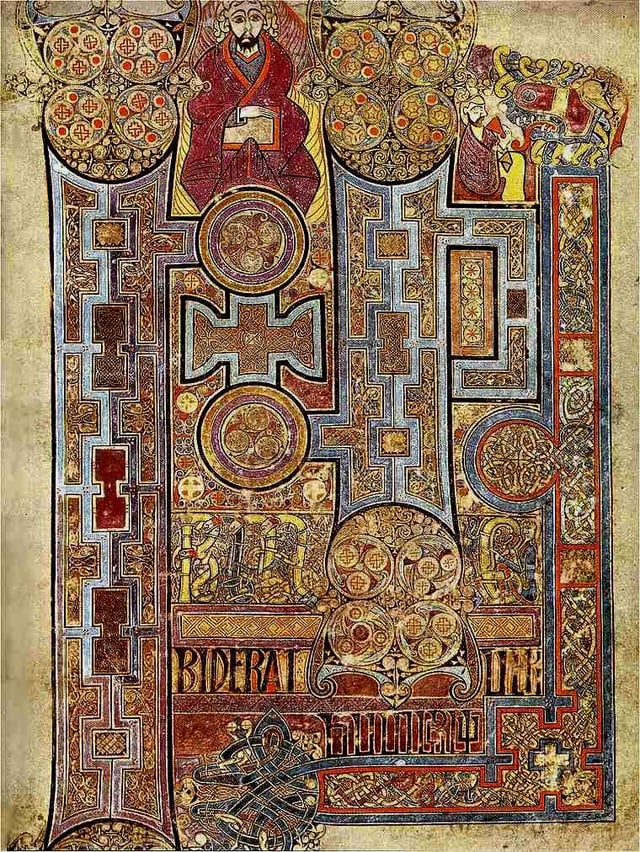
A page from the 9th century Book of Kells, one of the finest examples of Insular art. It is believed to have been made in Gaelic monasteries in Ireland and Scotland.
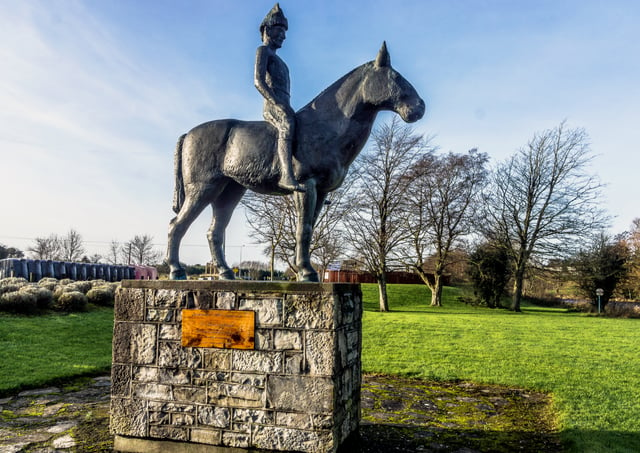
High King Máel Sechnaill mac Domnaill was one of the leaders in the struggle with the Norsemen.
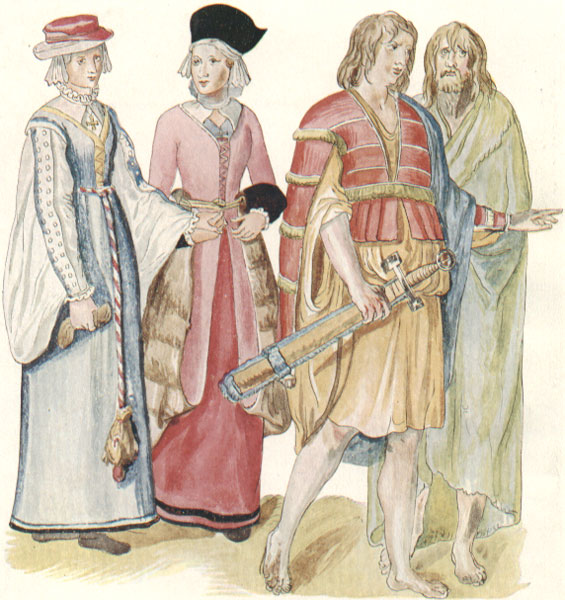
Gaelic Irish men and noblewomen, c.1575
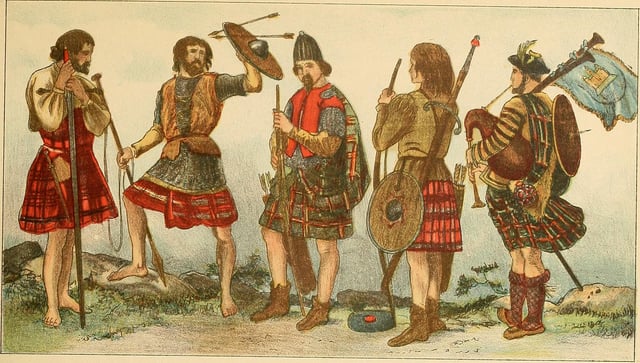
Scottish Highlanders depicted in R. R. McIan's Clans of The Scottish Highlands (1845)
Christianity reached Ireland during the 5th century, most famously through a Romano-British slave Patrick,[65] but also through Gaels such as Declán, Finnian and the Twelve Apostles of Ireland. The abbot and the monk eventually took over certain cultural roles of the aos dána (not least the roles of druí and seanchaí) as the oral culture of the Gaels was transmitted to script by the arrival of literacy. Thus Christianity in Ireland during this early time retained elements of Gaelic culture.[65]
In the Middle Ages, Gaelic Ireland was divided into a hierarchy of territories ruled by a hierarchy of kings or chiefs. The smallest territory was the túath (plural: túatha), which was typically the territory of a single kin-group. Several túatha formed a mór túath (overkingdom), which was ruled by an overking. Several overkingdoms formed a cóiced (province), which was ruled by a provincial king. In the early Middle Ages the túath was the main political unit, but during the following centuries the overkings and provincial kings became ever more powerful.[66][67] By the 6th century, the division of Ireland into two spheres of influence (Leath Cuinn and Leath Moga) was largely a reality. In the south, the influence of the Eóganachta based at Cashel grew further, to the detriment of Érainn clans such as the Corcu Loígde and Clann Conla. Through their vassals the Déisi (descended from Fiacha Suidhe and later known as the Dál gCais), Munster was extended north of the River Shannon, laying the foundations for Thomond.[68] Aside from their gains in Ulster (excluding the Érainn's Ulaid), the Uí Néill's southern branch had also pushed down into Mide and Brega. By the 9th century, some of the most powerful kings were being acknowledged as High King of Ireland.
Some, particularly champions of Christianity, hold the 6th to 9th centuries to be a Golden Age for the Gaels. This is due to the influence which the Gaels had across Western Europe as part of their Christian missionary activities. Similar to the Desert Fathers, Gaelic monastics were known for their asceticism.[69] Some of the most celebrated figures of this time were Columba, Aidan, Columbanus and others.[69] Learned in Greek and Latin during an age of cultural collapse,[70] the Gaelic scholars were able to gain a presence at the court of the Carolingian Frankish Empire; perhaps the best known example is Johannes Scotus Eriugena.[71] Aside from their activities abroad, insular art flourished domestically, with artifacts such as the Book of Kells and Tara Brooch surviving. Clonmacnoise, Glendalough, Clonard, Durrow and Inis Cathaigh are some of the more prominent Ireland-based monasteries founded during this time.
There is some evidence that the Gaels may have visited the Faroe Islands and Iceland before the Norse, and that Gaelic monks known as papar lived there before being driven out by the incoming Norsemen.[72]
The late 8th century heralded outside involvement in Gaelic affairs, as Norsemen from Scandinavia, known as the Vikings, began to raid and pillage settlements looking for booty. The earliest recorded raids were on Rathlin and Iona in 795; these hit and run attacks continued for some time until the Norsemen began to settle in the 840s at Dublin (setting up a large slave market), Limerick, Waterford and elsewhere. The Norsemen also took most of the Hebrides and the Isle of Man from the Dál Riata clans and established the Kingdom of the Isles.
At the same time, the Picts were becoming Gaelicised, and the Gaelic kingdom of Dál Riata merged with Pictland to form the Kingdom of Alba. Kenneth MacAlpin and the House of Alpin are most associated with this process.
After a spell when the Norsemen were driven from Dublin by Leinsterman Cerball mac Muirecáin, they returned in the reign of Niall Glúndub, heralding a second Viking period. The Dublin Norse—some of them, such as Uí Ímair king Ragnall ua Ímair now partly Gaelicised as the Norse-Gaels—were a serious regional power, with territories across Northumbria and York. At the same time, the Uí Néill branches were involved in an internal power struggle for hegemony between the northern or southern branches. Donnchad Donn raided Munster and took Cellachán Caisil of the Eóganachta hostage. The destabilisation led to the rise of the Dál gCais and Brian Bóruma. Through military might, Brian went about building a Gaelic Imperium under his High Kingship, even gaining the submission of Máel Sechnaill mac Domnaill. They were involved in a series of battles against the Vikings: Tara, Glenmama and Clontarf. The last of these saw Brian's death in 1014. Brian's campaign is glorified in the Cogad Gáedel re Gallaib
The Irish Church became closer to Continental models with the Synod of Ráth Breasail and the arrival of the Cistercians. There was also more trade and communication with Normanised Britain and France. Between themselves, the Ó Briain and the Ó Conchobhair attempted to build a national monarchy.
The remainder of the Middle Ages was marked by conflict between Gaels and Anglo-Normans. The Norman invasion of Ireland took place in stages during the late 12th century. Norman mercenaries landed in Leinster in 1169 at the request of Diarmait Mac Murchada, who sought their help in regaining his throne. By 1171 the Normans had gained control of Leinster, and King Henry II of England, with the backing of the Papacy, established the Lordship of Ireland. The Norman kings of England claimed sovereignty over this territory, leading to centuries of conflict between the Normans and the native Irish. The origins of a literary anti-Gaelic sentiment was born at this time, and developed by the likes of Gerald of Wales, as part of a propaganda campaign (with a Gregorian "reform" gloss) to justify taking Gaelic lands. Scotland also came under Anglo-Norman influence in the 12th century. The Davidian Revolution saw the Normanisation of Scotland's monarchy, government and church; the founding of burghs, which became mainly English-speaking; and the royally-sponsored immigration of Norman aristocrats.[73] This Normanisation was mainly limited to the Scottish Lowlands. In Ireland, the Normans carved out their own semi-independent lordships, but many Gaelic Irish kingdoms remained outside Norman control and gallowglass warriors were brought in from the Highlands to fight for various Irish kings.
In 1315, a Scottish army landed in Ireland as part of Scotland's war against England. It was led by Edward Bruce, brother of Scottish king Robert the Bruce. Despite his own Norman ancestry, Edward urged the Irish to ally with the Scots by invoking a shared Gaelic ancestry and culture, and most of the northern kings acknowledged him as High King of Ireland.[74] However, the campaign ended three years later with Edward's defeat and death in the Battle of Faughart.
A Gaelic Irish resurgence began in the mid-14th century: English royal control shrank to an area known as the Pale and, outside this, many Norman lords adopted Gaelic culture, becoming culturally Gaelicised. The English government tried to prevent this through the Statutes of Kilkenny (1366), which forbade English settlers from adopting Gaelic culture, but the results were mixed and particularly in the West, some Normans became Gaelicised.
Imperial
During the 16th and 17th centuries, the Gaels were affected by the policies of the Tudors and the Stewarts who sought to anglicise the population and bring both Ireland and the Highlands under stronger centralised control,[75] as part of what would become the British Empire. In 1542, Henry VIII of England declared the Lordship of Ireland a Kingdom and himself King of Ireland. The new English, whose power lay in the Pale of Dublin, then began to conquer the island. Gaelic kings were encouraged to apply for a surrender and regrant: to surrender their lands to the king, and then have them regranted as freeholds. Those who surrendered were also expected to follow English law and customs, speak English, and convert to the Protestant Anglican Church. Decades of conflict followed in the reign of Elizabeth I, culminating in the Nine Years' War (1594–1603). The war ended in defeat for the Irish Gaelic alliance, and brought an end to the independence of the last Irish Gaelic kingdoms.
In 1603, with the Union of the Crowns, King James of Scotland also became king of England and Ireland. James saw the Gaels as a barbarous and rebellious people in need of civilising,[76]*The%20Making%20of%20the%20British%20I]]*nd believed that Gaelic culture should be wiped out. the Irish Gaelic alliance fled Ireland in 1607, their lands were confiscated. James set about colonising this land with English-speaking Protestant settlers from Britain, in what became known as the Plantation of Ulster. It was meant to establish a loyal British Protestant colony in Ireland's most rebellious region and to sever Gaelic Ulster's links with Gaelic Scotland.[76] In Scotland, James attempted to subdue the Gaelic clans and suppress their culture through laws such as the Statutes of Iona.[75] He also attempted to colonise the Isle of Lewis with settlers from the Lowlands.
Since then, the Gaelic language has gradually diminished in most of Ireland and Scotland.
The 19th century was the turning point as The Great Hunger in Ireland, and across the Irish Sea the Highland Clearances, caused mass emigration (leading to Anglicisation, but also a large diaspora). The language was rolled back to the Gaelic strongholds of the north west of Scotland, the west of Ireland and Cape Breton Island in Nova Scotia.
Modern
The Gaelic revival also occurred in the 19th century, with organisations such as Conradh na Gaeilge and An Comunn Gàidhealach attempting to restore the prestige of Gaelic culture and the socio-communal hegemony of the Gaelic languages. Many of the participants in the Irish Revolution of 1912–1923 were inspired by these ideals and so when a sovereign state was formed (the Irish Free State), post-colonial enthusiasm for the re-Gaelicisation of Ireland was high and promoted through public education. Results were very mixed however and the Gaeltacht where native speakers lived continued to retract. In the 1960s and 70s, pressure from groups such as Misneach (supported by Máirtín Ó Cadhain), the Gluaiseacht Chearta Siabhialta na Gaeltachta and others; particularly in Connemara; paved the way for the creation of development agencies such as Údarás na Gaeltachta
The last native speaker of Manx died in the 1970s, though use of the Manx language never fully ceased. There is now a resurgent language movement and Manx is once again taught in all schools as a second language and in some as a first language.
Culture
Gaelic society was traditionally made up of kin groups known as clans, each with its own territory and headed by a male chieftain.
Succession to the chieftainship or kingship was through tanistry. When a man became chieftain or king, a relative was elected to be his deputy or 'tanist' (tánaiste). When the chieftain or king died, his tanist would automatically succeed him. The tanist had to share the same great-grandfather as his predecessor (i.e. was of the same derbfhine) and he was elected by freemen who also shared the same great-grandfather.[78][79]A%20handbook%20of%20the%20Scottis]]aelic law is known as the[[80]](https://openlibrary.org/search?q=Glaser%2C%20Konstanze%20%282007%29.%20 [[CITE|80|https://openlibrary.org/search?q=Glaser%2C%20Konstanze%20%282007%29.%20*Minority%20Languages%20and%20)roundhouses ringforts belted plaid kilt music nd their own sports (see Gaelic games and Highland games).
Language
Emergence
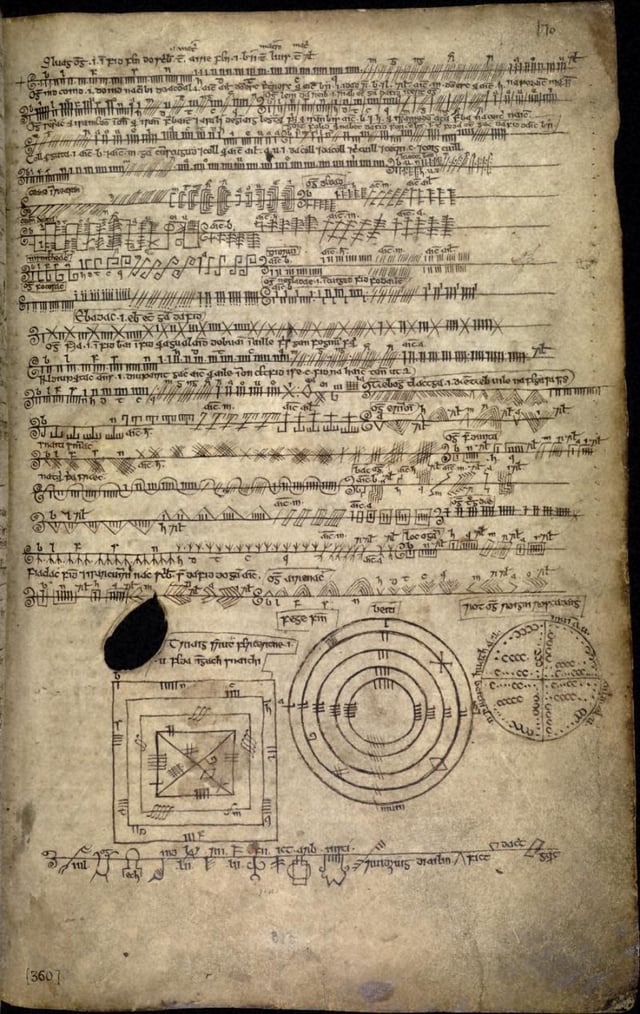
Auraicept na n-Éces, 7th century, explaining ogham.
The Gaelic languages are part of the Celtic languages and fall under the wider Indo-European language family. There are two main historical theories concerning the origin and development of the Gaelic languages from a Proto-Celtic root: the North Atlantic-based Insular Celtic hypothesis posits that Goidelic and Brythonic languages have a more recent common ancestor than Continental Celtic languages, while the Q-Celtic and P-Celtic hypothesis posits that Goidelic is more closely related to the Celtiberian language, while Brythonic is closer to the Gaulish language.
Estimates of the emergence of proto-Gaelic in Ireland vary widely from the introduction of agriculture c. 7000–6000 BC to around the first few centuries BC.
Little can be said with certainty, as the language now known as Old Irish—ancestral to modern Irish, Scots Gaelic and Manx—only began to be properly recorded with the Christianisation of Ireland in the 4th century, after the introduction of the Roman script. Primitive Irish does appear in a specialised written form, using a unique script known as Ogham. The oldest examples of Ogham have survived in the form of memorial inscriptions or short epitaphs on pillar-like stone monuments (see Mac Cairthinn mac Coelboth). Ogham stones are found throughout Ireland and neighbouring parts of Britain. This form of written Primitive Irish is thought to have been in use as early as 1000 BC. The script frequently encodes a name or description of the owner and surrounding region, and it is possible that the inscribed stones may have represented territorial claims.
Contemporary
The Gaelic languages have been in steep decline since the beginning of the 19th century, when they were majority languages of Ireland and the Scottish Highlands; today they are endangered languages.[81][82] The spread of the English language has resulted in a vast majority of people of Gaelic ancestry being unable to speak a Goidelic language. As far back as the Statutes of Kilkenny in 1366, the British government had dissuaded use of Gaelic for political reasons.[83] The Statutes of Iona in 1609 and the SSPCK in the Highlands (for most of its history) are also notable examples. As the old Gaelic aristocracy were displaced or assimilated, the language lost its prestige and became primarily a peasant language, rather than one of education and government.
During the 19th century, a number of Gaeilgeoir organisations were founded to promote a broad cultural and linguistic revival. Conradh na Gaeilge (English: the Gaelic League) was set up in 1893 and had its origins in Charles Owen O'Conor's Gaelic Union, itself a derivative of the Society for the Preservation of the Irish Language. Similar Highland Gaelic groups existed, such as An Comunn Gàidhealach. At this time, Irish Gaelic was widely spoken along the Western seaboard (and a few other enclaves) and the Gaelic League began defining it as the "Gaeltacht", idealised as the core of true Irish-Ireland, rather than the Anglo-dominated Dublin.[84] Although the Gaelic League itself aimed to be apolitical, this ideal was attractive to militant republicans such as the Irish Republican Brotherhood, who formulated and led the Irish Revolution at the turn of the 20th century; a key leader, Pádraig Pearse, imagined an Ireland "Not merely Free but Gaelic as well – Not merely Gaelic but Free as well." Scottish Gaelic did not undergo as extensive of a politicalisation at this juncture, as nationalists there tended to focus on the Lowland mythos of William Wallace rather than the Gàidhealtachd.[85]
During the 1950s, the independent Irish state developed An Caighdeán Oifigiúil as a national standard for the Irish language (using elements from local dialects but leaning towards Connacht Irish), with a simplified spelling. Until 1973, school children had to pass Modern Irish to achieve a Leaving Cert and studying the subject remains obligatory. There are also Gaelscoileanna where children are taught exclusively through the medium of Irish. In the Gaeltacht itself, the language has continued to be in crisis under the pressure of globalism, but there are institutions such as Údarás na Gaeltachta and a Minister for the Gaeltacht, as well as media outlets such as TG4 and RTÉ Raidió na Gaeltachta to support it. The last native Manx Gaelic speaker died in 1974, although there are ongoing attempts at revival.[86] While the Gàidhealtachd has retracted in the Highlands, Scottish Gaelic has enjoyed renewed support[87] with the Gaelic Language (Scotland) Act 2005, establishing the Bòrd na Gàidhlig under the devolved Scottish Government. This has seen the growth of Gaelic medium education. There are also media outlets such as BBC Alba and BBC Radio nan Gàidheal, although these have been criticized for excessive use of English and pandering to an English-speaking audience.[88]
Religion
Pre-Christian
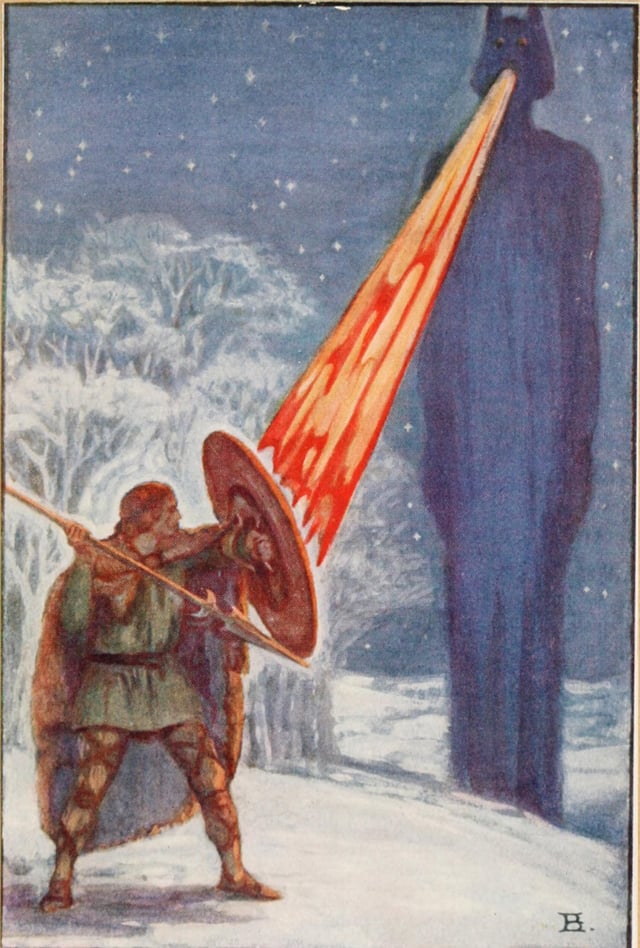
An artistic rendering of the hero Fionn mac Cumhaill
The traditional, or "pagan", worldview of the pre-Christian Gaels of Ireland is typically described as animistic,[89] polytheistic, ancestor venerating and focused on the hero cult of archetypal Gaelic warriors such as Cú Chulainn and Fionn mac Cumhaill. The four seasonal festivals celebrated in the Gaelic calendar, still observed to this day, are Imbolc, Beltane, Lughnasadh and Samhain.[90] While the general worldview of the Gaelic tradition has been recovered, a major issue for academic scholars is that Gaelic culture was oral prior to the coming of Christianity and monks were the first to record the beliefs of this rival worldview as a "mythology". Unlike other religions, there is no overall "holy book" systematically setting out exact rules to follow, but various works, such as the Lebor Gabála Érenn, Dindsenchas, Táin Bó Cúailnge and Acallam na Senórach, represent the metaphysical orientation of Gaelachas.
The main gods held in high regard were the Tuatha Dé Danann, the superhuman beings said to have ruled Ireland before the coming of the Milesians, known in later times as the aes sídhe.[91] Among the gods were male and female deities such as The Dagda, Lugh, Nuada, The Morrígan, Aengus, Brigid and Áine, as well as many others. Some of them were associated with specific social functions, seasonal events and personal archetypal qualities. Some physical locations of importance in Ireland related to these stories include the Brú na Bóinne, Hill of Tara and Hill of Uisneach. Although the sídhe were held to intervene in worldly affairs sometimes, particularly battles and issues of sovereignty, the gods were held to reside in the Otherworld, also known as Mag Mell (Plain of Joy) or Tír na nÓg (Land of the Young). This realm was variously held to be located on a set of islands or underground. The Gaels believed that certain heroic persons could gain access to this spiritual realm, as recounted in the various echtra (adventure) and immram
Christianity
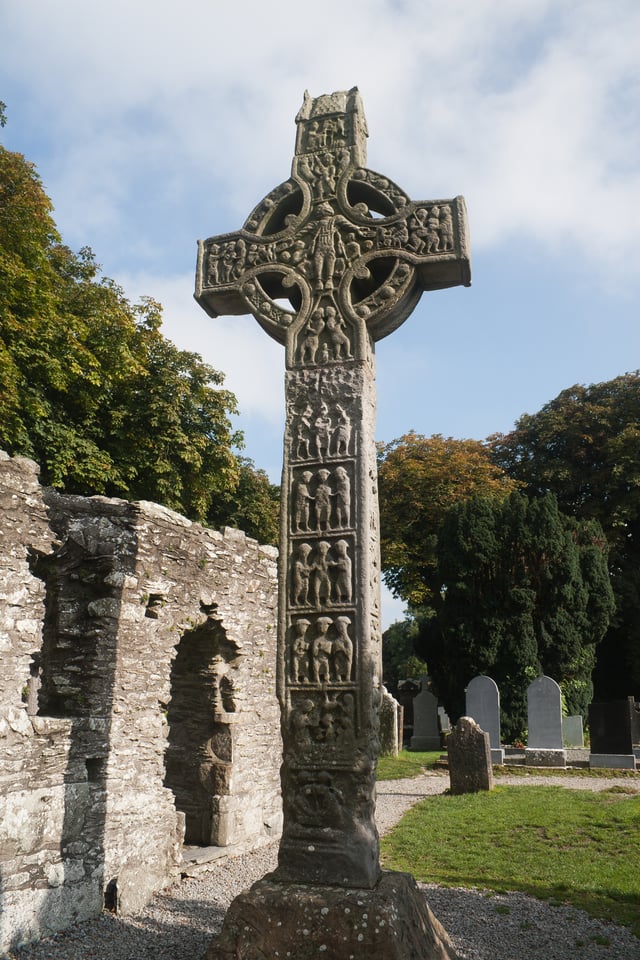
Medieval high cross at Monasterboice
The Gaels underwent Christianisation during the 5th century and that religion, de facto, remains the predominant one to this day, although irreligion is fast rising.[92] At first the Christian Church had difficulty infiltrating Gaelic life: Ireland had never been part of the Roman Empire and was a decentralised tribal society, making patron-based mass conversion problematic.[65] It gradually penetrated through the remnants of Roman Britain and is especially associated with the activities of Patrick, a Briton who had been a slave in Ireland.[65] He tried to explain its doctrines by using elements of native folk tradition, so Gaelic culture itself was not completely cast aside and to some extent local Christianity was Gaelicised.[65] The last High King inaugurated in the pagan style was Diarmait mac Cerbaill. The 6th–9th centuries are generally held to be the height of Gaelic Christianity, with numerous saints, scholars and works of devotional art.
This balance began to unravel during the 12th century with the polemics of Bernard of Clairvaux, who attacked various Gaelic customs (including polygamy[93] and hereditary clergy) as "pagan".[94] The Catholic Church of the time, fresh from its split with the Orthodox Church, was becoming more centralised and uniform throughout Europe with the Gregorian Reform and military reliance on Germanic peoples at the fringes of Latin Christendom, particularly the warlike Normans. As part of this, the Catholic Church actively participated in the Norman conquest of Gaelic Ireland, with the issuing of Laudabiliter (claiming to gift the King of England the title "Lord of Ireland") and in Scotland strongly encouraged king David who Normanised that country. Even within orders such as the Franciscans, ethnic tensions between Norman and Gael continued throughout the later Middle Ages,[95] as well as competition for ecclesiastic posts.
During the 16th century, with the emergence of Protestantism and Tridentine Catholicism, a distinct Christian sectarianism made its way into Gaelic life, with societal effects carrying on down to this day. The Tudor state used the Anglican Church to bolster their power and enticed native elites into the project, without making much initial effort to convert the Irish Gaelic masses; meanwhile, the mass of Gaeldom (as well as the "Old English") became staunchly Catholic. Due to the geopolitical rivalry between Protestant Britain and Catholic France and Spain, the Catholic religion and its mostly Gaelic followers in Ireland were persecuted for a long time. In the Scottish Highlands too, the Gaels were generally slow to accept the Scottish Reformation. Efforts at persuading Highlanders in general of the value of this primarily Lowland movement were hampered by the complicated politics of the Highlands, with religious rivalries and clan antagonism becoming entwined (a prominent example was the intense rivalry, even hatred, between the generally Presbyterian Campbells and the generally Catholic MacDonalds), but most Highlanders later converted to Presbyterianism in the 19th century during the breakdown of the clan system. In a few remote areas, however, Catholicism was kept alive and even rejuvenated to some extent by Irish Franciscan missionaries, but in most of the Highlands it was replaced by Presbyterianism.